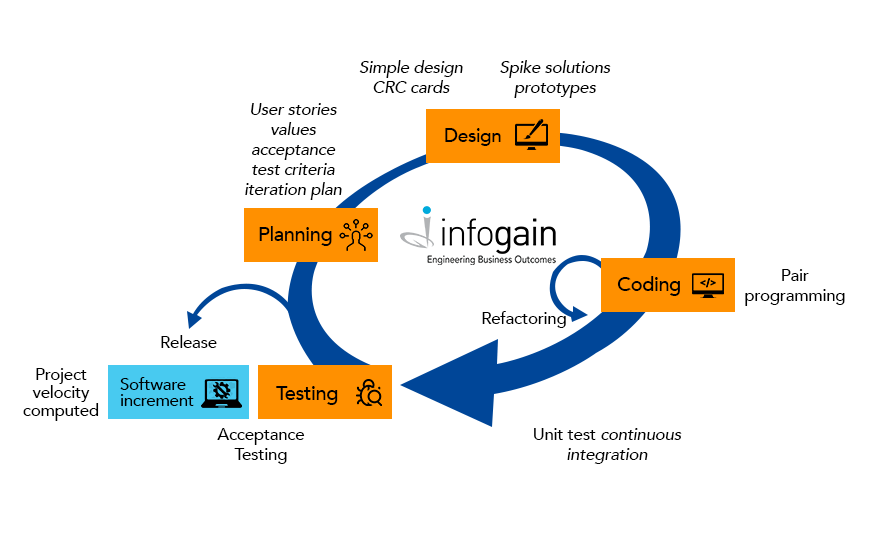- Posted on : July 31, 2019
-
- Industry : Corporate
- Type: Blog

Authored by Nitin Shrivastava - Technology Advisor & Rashmi Gupta - Program Manager
Extreme programming (XP) is one of the most important software development frameworks of the Agile model. When it is used to improve software quality and responsiveness to customer requirements, XP is an efficient way to organize projects and develop software and collaborate on code and how best to increase developers' productivity.
The principles of XP are centered on customer satisfaction and empowering developers to confidently respond to dynamic customer requirements, however late in the development cycle. XP is team oriented; it implements a simple, yet effective environment enabling teams to become highly productive and efficient.
Extreme programming’s basic functions and activities include:
- Code Review detects and corrects errors efficiently. It suggests pair programming as coding and reviews the written code carried out between a pair of programmers who switch their work every hour.
- Pair programming helps with hotfixes that need to be released immediately and new feature development where complex business rules are to be implemented. It helps new team members understand the application code faster and become more productive.
- Daily group reviews ensure the new additions to the codes are as per the coding standards and the changes do not adversely impact other areas of development lifecycle.
- Testing codes check for errors and improves its reliability. XP promotes Test-Driven Development (TDD) to continually write and execute test cases. In the TDD approach, test cases are written prior to the code. The TDD approach in insurance project helps to find complex business scenarios which can impact other business rules.
- Incremental development proves very effective specially after a customer feedback when the development team adds new increments every few days after each iteration.
- Simplicity makes it easier to develop good quality code, to test and to debug it.
- Design is the most important component to developing a good quality
- Integration testing helps with identifying bugs at the interface of different functionalities. XP recommends that developers follow continuous integration by building and performing integration testing several times a day.
-
- Dev/QA environment is regularly updated to help the team test in a production environment with data and the new code base.
- Sandbox environments are provided for the team to quickly create an integrated testing environment with the latest code, so developers can test the code within sprint cycles.

While there are several advantages of following an extreme programming framework, it is important to ascertain a company’s size, structure and expertise base to allow for applying XP practices. Some factors to consider include:
- XP was designed to help development teams adapt to fast-changing requirements, making it suitable for the ‘highly adaptive’ software development style.
- The projects are risky, perhaps a shorter deadline to be met, problems connected with working on a new system; XP practices are most adept with handling these.
- Team size is essential to successful XP implementations. A team of 12 or less is typically efficient for XP.
- Developers’ ability to create and run unit tests, automated testing.
- XP is customers centric, requiring customer participation to work with developers and managers side-by-side. It is mandatory that the client be available in the same office.
Extreme Programming is for the team that defines collaboration and continuous development with high importance. XP ensures a healthy product because it anticipates errors, is highly adaptable and requires ongoing feedback from customers.
For questions and comments, or to speak to an expert, contact us here.






